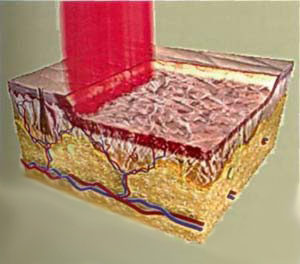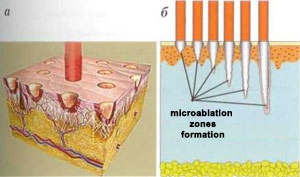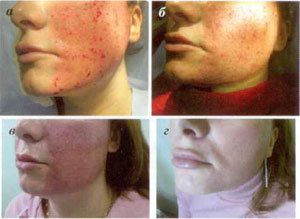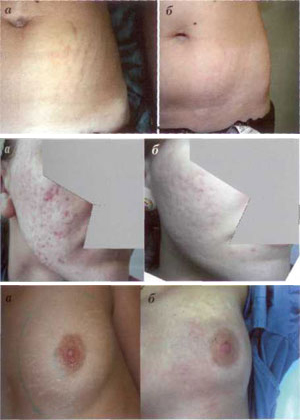This development is particularly typical of hardware methods, primarily laser drugs. The use of lasers, first in skin diseases and then in cosmetology, has a glorious period. Even since the appearance of one of the latest laser treatment techniques - specific phototherapy - it has been more than 25 years. The pioneers of this field, the Americans RR Anderson and JA Parrish, decided on the fate of fracturing techniques in medicine and made them indispensable in the treatment of such an aesthetic imperfection in the skin as a carotid artery tumor. Port wine stains, hyperplasia, tattoos, rosacea, pigmentation disorders, photography, wrinkles, etc. s. etc.
Modern skin repair techniques
We live in a time when more people are living to old age than ever before. And given that many of them continue to live an active life, one of the most important problems in aesthetic medicine is the fight against skin aging.
Plastic surgery can restore the shape of the face by removing excess skin. At the same time, however, the skin changes over time (age-related aging) or external factors (photography). It is also important that most patients want to look younger without surgery.
In this case, what method should be used to affect the skin and what should be done in it for its actual rejuvenation?
All the methods that can be used to improve the appearance of the skin are combined with one principle - they use traumatic effects on the skin and provoke joint tissue, which further leads to tension and tightening.
Dermatocosmetology currently uses three main types of skin rejuvenating effects, including:
- Chemical stimulation - chemical peeling with acids (trichloroacetic acid, glucose balloon, etc. );
- thermal - laser radiation, heat treatment with laser and broadband light sources, radiation of frequency, refraction methods.
Chemical stimulation
Historically, exfoliation was the first method of skin rejuvenation. The principle of exfoliation is partial (as with superficial exfoliation) or almost perfect (as with middle and deep exfoliation) destruction of epidermis, damaged fibroblasts and dermis structures. This damage activates the inflammatory response (the more powerful, the greater the volume of the destruction itself), leading to the additional production of collagen in the skin.
To achieve the desired results, peeling must sacrifice the epidermis. Experiments with burns have misled many, allegedly "proving" that the epidermis is a self-regenerating organ that quickly heals over damaged areas. In this regard, peeling for some time became increasingly aggressive towards the epidermis (for example, deep phenolic peeling), until eventually accumulated problems led to experts realizing the evil of this method which eventually leads to thinning of the skin.
Proponents of deep peeling ignored the problems that arise. Their essence was that due to the destruction of papillae by the skin and the weakening of nutrition, the epidermis becomes thinner and the number of cells in the stem layer is significantly reduced compared to what was before the peeling. A decrease in the obstruction of the stratum corneum leads to a decrease in the hydration of the skin. (Therefore, after deep peeling for a long time, almost all patients experience significant dryness of the skin). lighter skins (using trichloroacetic acid and fruit acids) did not meet the expectations placed on them for effective hardening.
Mechanical stimulation
Of the methods of mechanical stimulation of undivided changes in the skin, dermabrasion using a rotating device (with a speed of v; rotation cuts up to 100, 000 revolutions per minute) deserves special attention. Modern Schumann-Schreus devices (Germany) are currently usedThe procedure can only be used in a surgical hospital, where the operation requires anesthesia, after surgery on the surface of the wound, a special toilet for the eyes and mouth, as well as a device for breastfeeding patients (due to prominent edema after the operation that appears 2-3days after the operation makes it difficult to open eyes and mouth).
The method is very effective, but unfortunately, with mechanical dermabrasion, there is a high risk of complications such as:
- persistent ischemia after surgery;
- Disappearance of areas due to the destruction of melanocytes when the vessel passes through the basement membrane;
- wound surface infection;
- arrow (if the boat is too deep into the skin)
All of the above has determined the limited application of this method in clinical practice.
Thermal stimulation
Reconstruction Structure
In the late 1980's, laser has been used to rejuvenate the skin by removing layer by layer of tissue (elimination) [4]. Carefully, a little trauma removes the surface layer of the skin with a carbon dioxide solvent stimulates the formation of its own collagen in it, its amount increases several times after the operation. Then it is gradually reorganized.
The most effective was the use of CO2 laser, when exposed to deep heat on all layers of the skin flow, which is manifested on the outside by the effects of hardened skin. The method is called "laser dermabrasion", or "laser resurfacing", and in terms of effectiveness it could not be opposed with any other method of skin rejuvenation that existed at the time (Figure 1).

image. 1. Organization of conventional laser dermabrasion
However, the CO2 laser also causes a large number of complications. In addition, further studies have shown that such a profound effect on the skin stimulates the formation of fibrous tissue to a greater extent than promotes the formation of new, normalized collagen [5]. Developed fibrosis can make the skin abnormally pale. Collagen, which is formed after treatment, is absorbed after a few years, like all collagen that is formed at the site of the scar. As a result of the thinning epidermis caused by shrinkage of the papillary layer in the skin, fine wrinkles begin to appear on the skin. Due to the weakening of the stratum corneum, the hydration level of the skin decreases and it looks like shrinkage.
Erbium-aluminum-yttrium garnet-erbium laser appeared some time later. Such advantages erbium laser as a shallower thermal depth (erbium laser reach a depth of 30 μm, CO2 laser - up to 150 μm) and (as a result) lower risk of burns and carbonation in tissues, as well as relative cheapness (compared to carbon dioxide laser), raisedthe attention of many experts around the world.
Nevertheless, as experience of working with these two types of structures has accumulated, the opinion has developed among experts that CO2 lasers are more efficient [6]. Despite the negative effects of the carbon dioxide laser breakdown described above, these methods are still essential for the correction of acne. In addition, it can be considered as an alternative to skin surgery - of all the methods of its reconstruction, only exposure to CO2 solvent can actually cause a pronounced collagen contraction with a visible clinical lifting effect.
The problem with all of the methods described above is that they often "sacrifice", that is, severely damage the epidermis. To rejuvenate your skin and look really youthful, you need a perfect epidermis with natural papillae of dermis, good hydration, normal skin tone and elasticity. The epidermis is a very complex highly specialized organ, up to 200 microns thick, which is our only protection against the effects of negative environmental factors. Therefore, whatever we do to rejuvenate the skin, we must make sure that its underlying natural architecture is never damaged.
This concept promoted non-ablative reconstruction techniques.
Renewal Renewal
The most common skin improvement devices are non-neodymium (Nd-YAG) and diode laser, as well as broadband light source (IPL). The principle of their action - specific phototherapy - involves the heating and destruction of structures, which contain a sufficient amount of melanin or oxyhemoglobin. In the skin, these are the accumulation of melanoma (lentigo, melasma) and arrows (telangiectasia). The released wavelengths used in non-ablative solvent correspond to the peak absorption spectrum of oxyhemoglobin or melanin. The method of treatment with non-ablative and IPL lasers is completely safe, the recovery period is minimal, but such treatment eliminates only pigment and vascular cosmetic defects. In this case, there is a certain thickening of the skin, but the effect obtained is short-lived.
Skin Fracture Technology
The constant search for new, very effective and at the same time safe methods of skin rejuvenation has led to the emergence of revolutionary technology - a break in radiation therapy. The proposed method of skin rejuvenation has been specifically designed to overcome the axes of the above difficulties. Unlike "traditional" ablative and non-ablative laser methods, which are designed to achieve even thermal damage to the skin at a certain depth, fracture methods allow to achieve specific microscopic thermal damage in the form of numerous modified columns and leave intact areas around these micro-wounds. The industry currently produces two types of fractures: non-ablative and ablative.
The first uses an erbium-doped fiber that produces radiation at a wavelength of 1550 nm. Broken laser forms in the skin thousands and tens of thousands of micro-lesions in the form of columns - microbial treatment areas (MLZ) - with a diameter of 70-150mk up to 1359 mcm
As a result, about 15-35 blends of light are blended on the treated area. The chromophore for the solvent is water. Clotting mainly occurs in the lower layers of the epidermis and skin. Stratum corneum is unchanged because it contains a relatively small amount of water and it significantly reduces the risk of infection. Reconstruction of the epidermis is rapid due to the small volume of the wound and the short flow distance of the keratin cells. The treatment period is accompanied by moderate edema and ischemia, followed by desquamation, which appears at 5-7. day. The patient loses almost no social activity.
This technique - Fracture Measurement (FF) - is a very effective method for repairing skin fractures. To achieve the desired effect, treatment is prescribed during the course. It is recommended, depending on clinical condition performance, from 3 to 6 operations at 4-6 week intervals. As with all non-refundable skin rejuvenation procedures, the final result can be seen only 4-8 months after the operation (cumulative effect).

In cases where a more aggressive effect on the skin is needed - to correct scars, remove deep wrinkles and excess skin, the Fracture Fracture (FA or FDDA) method is used.
The elimination method combines the advantages of a CO2 solvent and the violation of the principle of emission of radiation. In contrast to conventional CO2 lasers, which remove the entire surface of the skin layer by layer, FA units form a huge number of microbial areas (MAL) up to 300 µm in diameter at an evaporation depth of 350 to 1800 µm (Figure 2).
Thus, in this operation, laser radiation, which enters the deep layers of the skin, destroys the upper layer of the epidermis. In terms of efficiency, ablative, refractive laser replacement can be applied during plastic surgery, this is how deep the laser beam reappears.
image. 2. Principle of use of the ablative modifier: formation of microflow regions - MAZ (a); depending on the depth of formation of the MAZ on the radiation beam (b)
As with FF, from 15 to 35% of the skin in the treated area is actually exposed (in some cases up to 70%). Recovery after FA procedure is faster than after layer-by-layer removal. This is because a significant portion of the epidermis and stratum corneum remain unchanged. Skin bleeding is seen for some time immediately after the operation, but soon stops (Fig. 3 a, b).
image. Step-by-step skin restoration after fracture fracture: see immediately after treatment (a); every other day (b); after 5 days (c); 14 days (d) after one operation

Numerous microbubbles appear on the skin, causing complex changes that lead to the production of new collagen. After the bleeding has stopped, it is necessary to remove the serum fluid that remains on the surface of the skin. Its release is seen within 48 hours of the operation, until complete micro-microbial coverage takes place. During this period, the patient uses special wound healing external drugs. Usually begins from 3-4 days peeling and inflammation increases (Fig. 3 c). On the seventh day, these phenomena gradually disappear and redness is yet another noticeable side effect (Figure 3d). The length of the redness depends on the parameters of the laser radiation and the symptoms of the blood vessels in the skin. According to the author's observations, redness lasts no longer than 3 months.
Patient's loss of social activity after FA surgery lasts 5 to 10 days.
To prevent scarring and manifestation of color inflammation after inflammation, it is necessary to take good care of the skin. Decorative cosmetics can be used from 4-5 days. A prerequisite for good results is the use for at least 3 months after sunscreen cosmetics have been highly protected (SPF at least 50). The risk of pigmentation after inflammation occurs in 20% of patients and is generally higher in patients with skin IV-V light recommendations. Such discoloration is temporary and can last from 1 week to 3 months, depending on the depth of treatment and the area of treatment. To prevent it 1-2 weeks before the operation and during the next week after that, external drugs based on hydroquinone (4%) and tretinoin (0, 1%) are prescribed. The main effects on the facial skin after the FA procedure are the following: noticeable hardening and reduction of excess skin, smoothing of surface wrinkled skin, as well as skin affecting acne, reduction of indigestion, porosity.
This method was tested by the author and his colleagues to remove stretch marks on the skin. As shown in clinical trials, the method has shown high efficacy in eliminating almost all types of stretch marks, both obtained during puberty. period and birth. It was stated that the healing process on the skin of the body is different from that on the skin of the face.
Effects on skin rejuvenation when using a break glue device
Let's consider skin regeneration procedures when using refractories.
After exposure to the solvent, infectious inflammation develops in the area that forms the micro-ulcers. The more aggressive the laser, the more pronounced the inflammatory response, which actually stimulates the release after shock growth factors and infiltrates damaged tissue with fibroblasts. The subsequent reaction is accompanied by an automatic burst of cellular activity, which inevitably leads to fibroblasts starting to produce more collagen and elastin. The skin rejuvenation process consists of three classic regeneration stages:
- Stage I - change (inflammation of the tissues). Starts immediately after damage;
- II. stage - spread (tissue formation). Starts 3-5 days after injury and lasts for about 8 weeks;
- III. stage - tissue reconstruction. Lasts for 8 weeks to 12 months.
It should be noted that all three phases of skin regeneration are visible both after refraction and after fracture. But in the first case, the harmful effects of the solvent are moderately aggressive, as a result of which the cascade of inflammatory change is never too wild.
A completely different image is displayed after exposure to the fractional change solvent. The shock caused by this solvent breaks down blood vessels and blood cells and sera are released into the surrounding tissue. Full-blown skin rejuvenation - pha change begins - infectious inflammation develops. Platelets released from damaged vessels play an important role in activating blood clotting and releasing toxicological factors which, in turn, are attracted to other platelets, leukocytes and fibroblasts. Leukocytes, especially neutrophils, are involved in cleansing damaged tissue, removing fragments of necrosis that are partially destroyed by venous inflammation, and partially penetrating the surface of the skin in the form of microscopic debris consisting of subcutaneous and erythrocyte subcutaneousfrom spinal cord (MENO).
The distribution phase starts in about 5 days. During this period, neutrophils are replaced by single cells. Monocytes, keratinocytes and fibroblasts continue to affect growth factors and at the same time have the opposite effect. Keratinocytes stimulate the growth of the epidermis and the release of growth factors that are necessary to stimulate the production of collagen by fibroblasts. In this phase, new blood vessels form and the extracellular matrix is formed.
The final, uplifting, healing phase after solvent breakage lasts for several months.
On the fifth day after injury, the fibronectin matrix fits along the axis on which the fibroids are fed and with which collagen will be built. An important role in the formation of this matrix is played by the transformation of growth factor β (TGF-β is a strong neurotoxic drug for fiber blowing), as well as other growth factors. The primary form of collagen in the early stages of wound healing is type III collagen (this type of collagen is located at the top of the dry skin, just below the base of the epidermis). The longer the transition time, the more type III collagen will be produced, but in any case the amount will increase to a maximum of 5 to 7 days after damage. Type III collagen is gradually replaced by collagen at u. þ. b. yearType I that strengthens the strength of the skin. The blood circulation is gradually normalized, the skin becomes smoother and acquires a natural color.
Comparative Analysis of Skin Restoration Solutions
Briefly above, we present to your attention a diagram showing the relationship between efficiency and safety of redesigned laser skin methods.
Advantages of small action methods in fractions. The advantages of fracture methods used in clinical use include:
- controlled minimal skin damage. Histological examinations performed after the operation show an increase in papillae in the skin, which characterizes changes in the skin as a productive regeneration;
- its effective rejuvenation: the skin becomes thicker, collagen and elastin production increases significantly (more than 400% (! ));
- short healing time: on average 3 days after FF and 7-14 days after PA;
- minimum risk of overpainting;
- Possibility of performing the operation on patients with thin skin;
- Ability to heal any part of the body;
- the possibility of using light anesthesia: with refractive index measurement, only local anesthesia is used; in the case of a fracture, a combination of conduction and anesthesia in the filtrate is required;
- disappeared telangiectasias (due to rupture of blood vessels in so many places that their restoration is impossible).
Main tips for treatment breaks

Tips for fracture formation:
- increase in skin density in the early stages of aging. The FF method is relatively easy and can be given without fear. Therapeutic effects can be applied to neck, décolleté, arms, abdomen, thighs, mammary glands;
- skin photography;
- discoloration, melasma;
- hypertensive arrow;
- elastic mark.
Fragmentation tips:
- wrinkles of varying severity - from fine lines to strongly prominent (in the form of pines);
- age-related loss of skin elasticity and density;
- excess skin on eyelids, neck, face (as an alternative to plastic surgery);
- uneven skin texture;
- prominent photography on the skin;
- Inflammation;
- malformation of skin after injury, surgery;
- hyperplasia: melasma, lentiginosis, mottled pigment, etc.
- vascular disease;
- stretch skin;
- actinic keratosis.
Finally, a few words about the prospects for the use of laser technology in aesthetic medicine. We have to thank the manufacturers that they started to pay more attention to the safety of medical methods using lasers. Technologically evolving. However, the safety of the method was often sacrificed to increase its effectiveness. Or vice versa. Compromise was found in a new basic principle of introducing laser radiation into tissues. It should be noted that the inactivity remained the same: erbium, carbon dioxide, neodymium. This indicates that:
- First of all, laser skin rejuvenation is recognized as the most effective today;
- Secondly, the breadth of the coverage of aesthetic and dermatological problems solved by these methods is enormous - from skin rejuvenation to the treatment of congenital and acquired skin disorders;
- Third, with the advent of fracture technology, the safety and effectiveness of treatment have become predictable.















































































